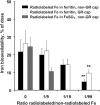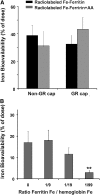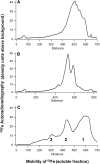Absorption of iron from ferritin is independent of heme iron and ferrous salts in women and rat intestinal segments
- PMID: 22259191
- PMCID: PMC3278266
- DOI: 10.3945/jn.111.145854
Absorption of iron from ferritin is independent of heme iron and ferrous salts in women and rat intestinal segments
Abstract
Ferritin iron from food is readily bioavailable to humans and has the potential for treating iron deficiency. Whether ferritin iron absorption is mechanistically different from iron absorption from small iron complexes/salts remains controversial. Here, we studied iron absorption (RBC (59)Fe) from radiolabeled ferritin iron (0.5 mg) in healthy women with or without non-ferritin iron competitors, ferrous sulfate, or hemoglobin. A 9-fold excess of non-ferritin iron competitor had no significant effect on ferritin iron absorption. Larger amounts of iron (50 mg and a 99-fold excess of either competitor) inhibited iron absorption. To measure transport rates of iron that was absorbed inside ferritin, rat intestinal segments ex vivo were perfused with radiolabeled ferritin and compared to perfusion with ferric nitrilotriacetic (Fe-NTA), a well-studied form of chelated iron. Intestinal transport of iron absorbed inside exogenous ferritin was 14.8% of the rate measured for iron absorbed from chelated iron. In the steady state, endogenous enterocyte ferritin contained >90% of the iron absorbed from Fe-NTA or ferritin. We found that ferritin is a slow release source of iron, readily available to humans or animals, based on RBC iron incorporation. Ferritin iron is absorbed by a different mechanism than iron salts/chelates or heme iron. Recognition of a second, nonheme iron absorption process, ferritin endocytosis, emphasizes the need for more mechanistic studies on ferritin iron absorption and highlights the potential of ferritin present in foods such as legumes to contribute to solutions for global iron deficiency.
Conflict of interest statement
Author disclosures: E. C. Theil, H. Chen, C. Miranda, H. Janser, B. Elsenhans, M. T. Núñez, F. Pizarro, and K. Schumann, no conflicts of interest.
Figures




References
-
- Andrews NC, Schmidt PJ. Iron homeostasis. Annu Rev Physiol. 2007;69:69–85 - PubMed
-
- McKie AT, Barrow D, Latunde-Dada GO, Rolfs A, Sager G, Mudaly E, Mudaly M, Richardson C, Barlow D, Bomford A, et al. An iron regulated ferric reductase associated with the absorption of dietary iron. Science. 2001;291:1755–9 - PubMed
-
- Laftah AH, Latunde-Dada GO, Fakih S, Hider RC, Simpson RJ, McKie AT. Haem and folate transport by proton-coupled folate transporter/haem carrier protein 1 (SLC46A1). Br J Nutr. 2009;101:1150–6 - PubMed
-
- Liu X, Theil EC. Ferritin: dynamic management of biological iron and oxygen chemistry. Acc Chem Res. 2005;38:167–75 - PubMed
Publication types
MeSH terms
Substances
Grants and funding
LinkOut - more resources
Full Text Sources
Other Literature Sources

